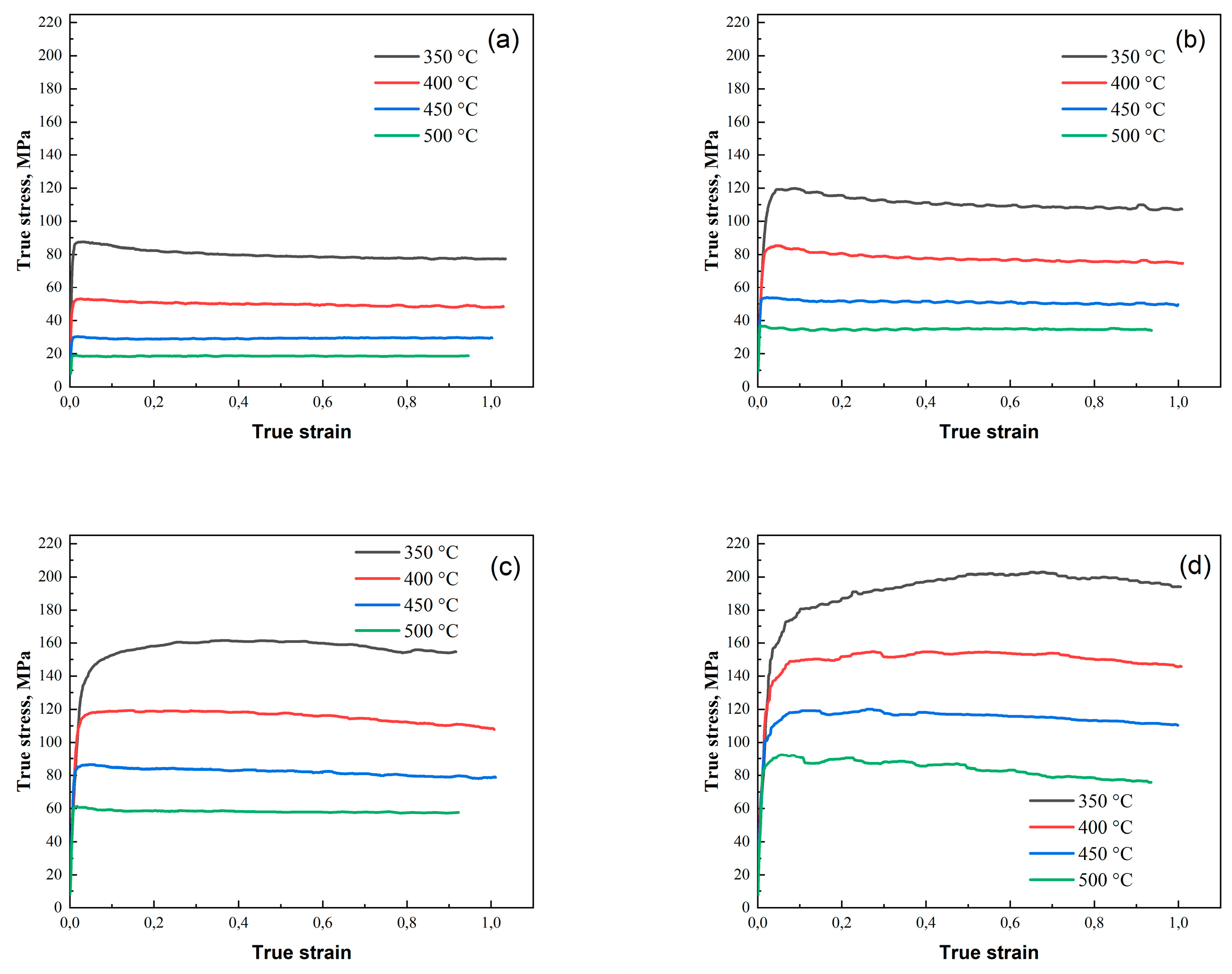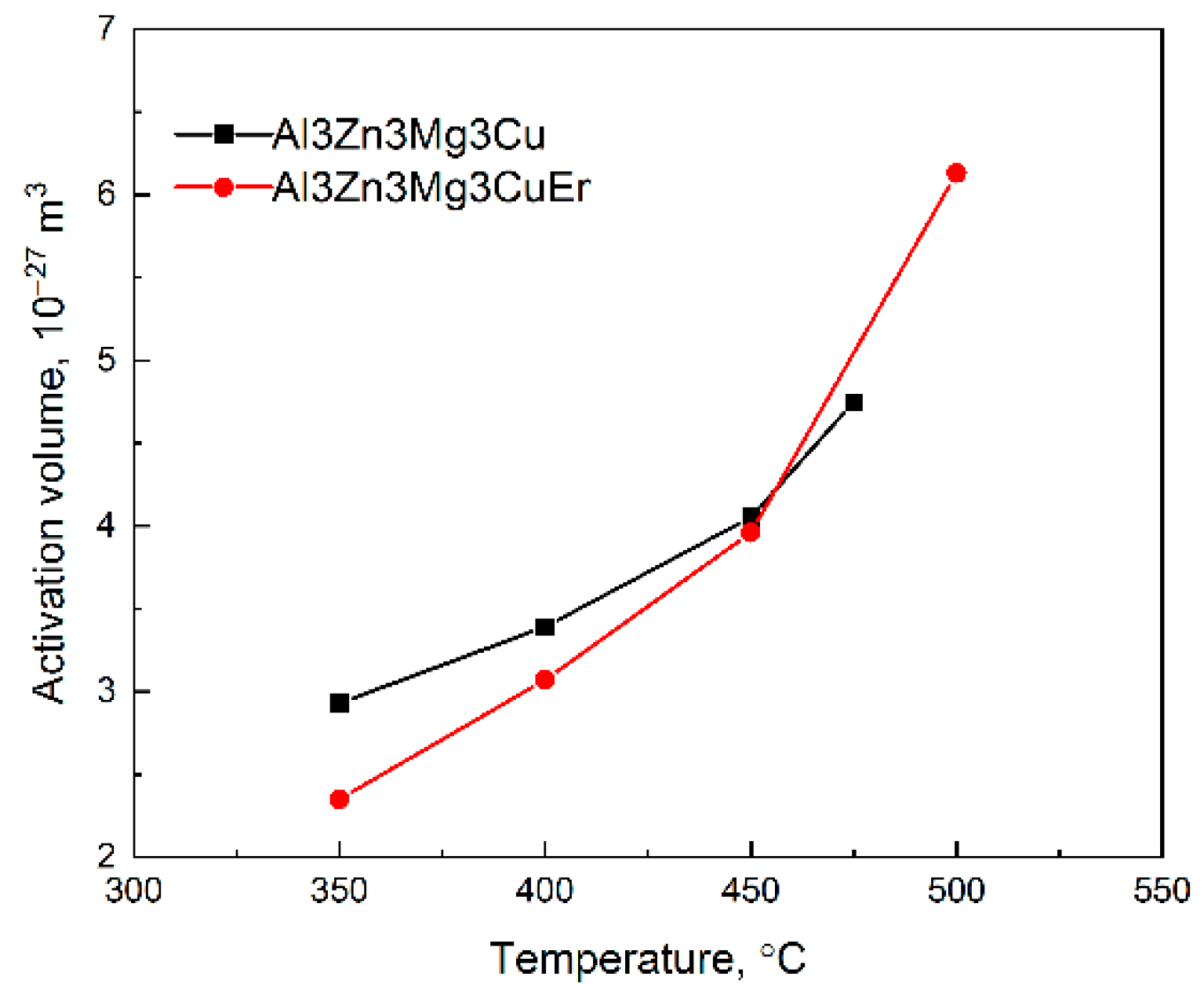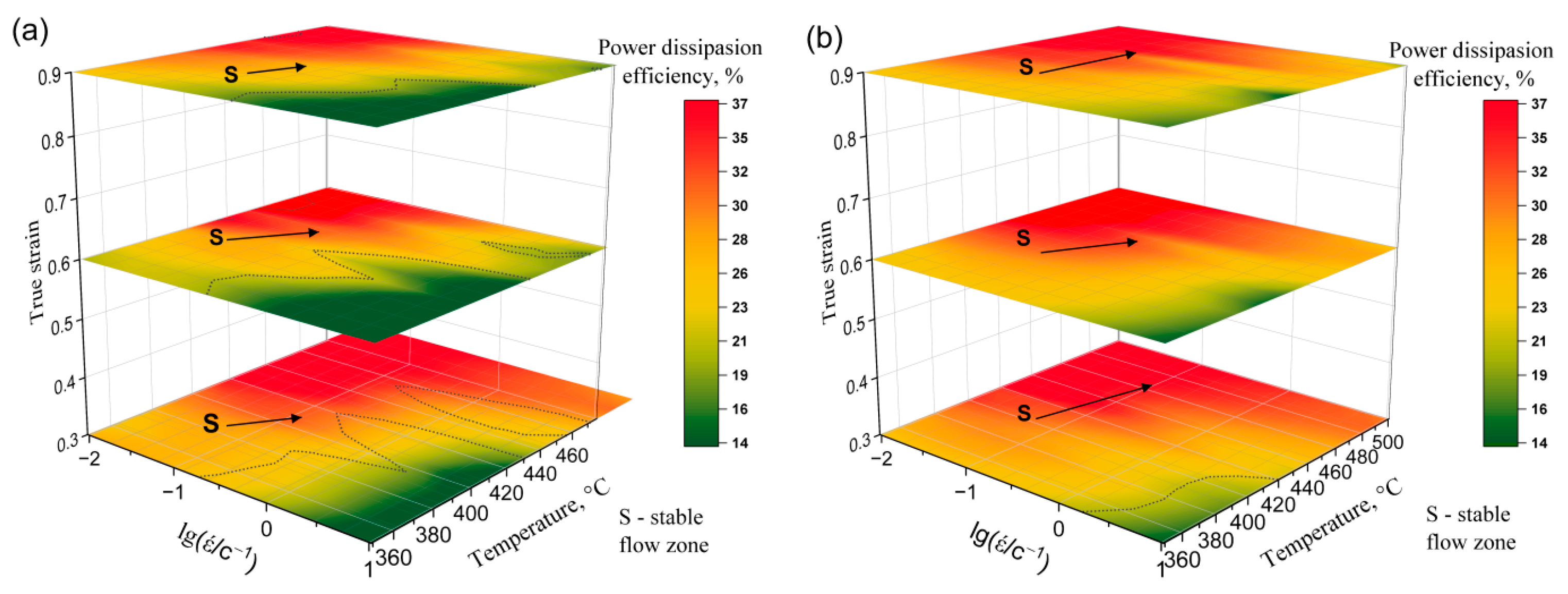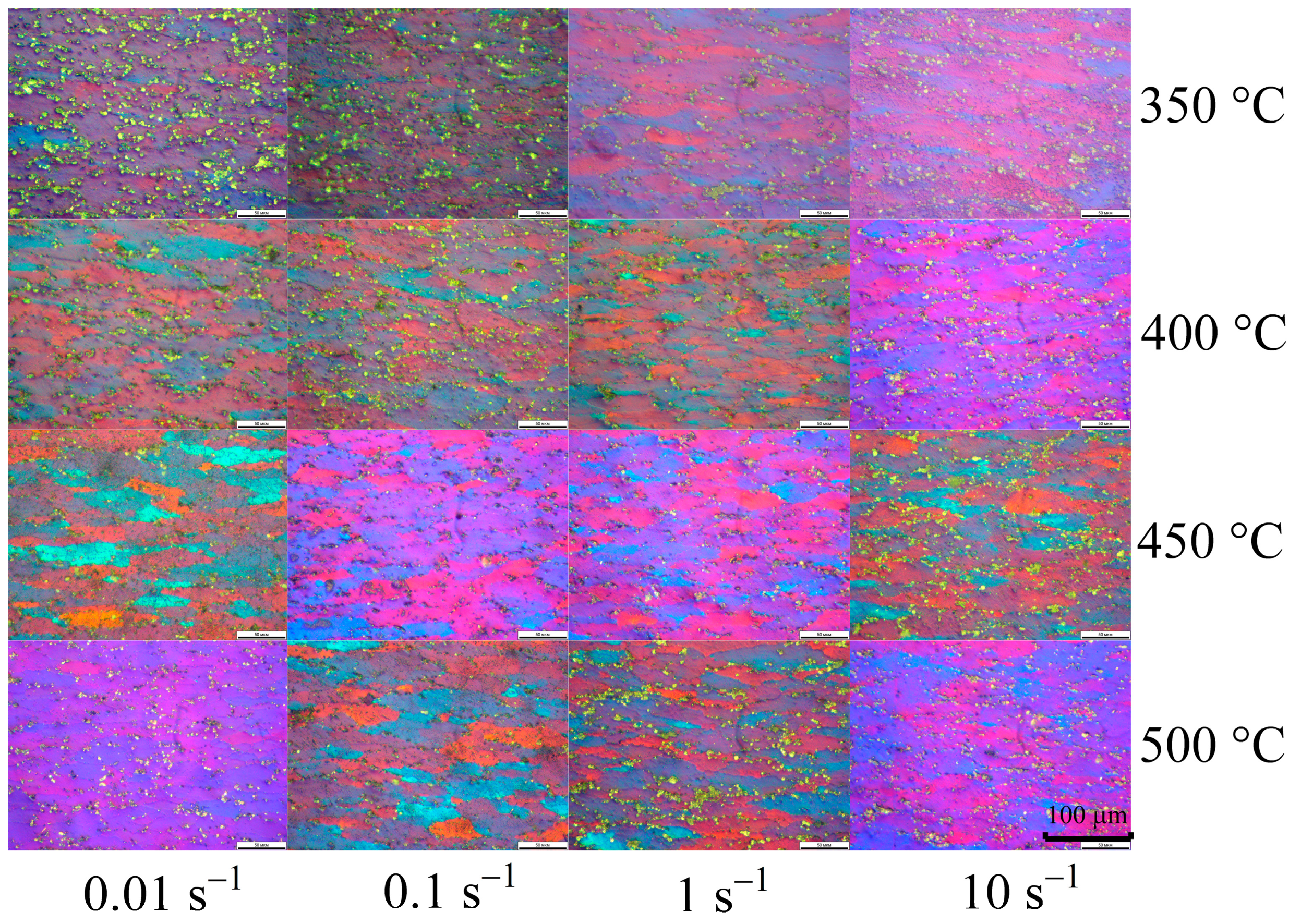Effect of Er on the Hot Deformation Behavior of the Crossover Al3Zn3Mg3Cu0.2Zr Alloy
Abstract
:1. Introduction
2. Materials and Methods
2.1. Alloy Melting
2.2. Sample Preparation and Structure Investigation
2.3. Hot Compression Testing
3. Results and Discussion
3.1. Microstructure Analysis of As-Cast and Solution-Treated Alloys
3.2. Hot Deformation Behavior
3.3. Hot Processing Maps
- -
- Increasing the solidus temperature increases the hot deformation temperature;
- -
- Increasing the volume fraction of the solidification origin particles decreases the effective activation energy;
- -
- Increasing the volume fraction of the finer L12 precipitates suppresses recrystallization and provides stable hot deformation.
4. Conclusions
- The formation of precipitates during the Er alloying of the Al3Zn3Mg3Cu0.2Zr alloy was investigated. Erbium addition to the alloy enabled the formation of more stable and fine L12-(Al3(Zr,Er)) precipitates, with sizes of 20–60 nm after two-stage solution treatment and higher temperatures during the second stage.
- The investigated alloys demonstrated typical hot deformation behavior. True stress tended to increase with a decline in the temperature and an increase in the deformation rate. The addition of Er led to decreases in true stress at strain rates of 0.01–1 s−1 due to particle-stimulated nucleation-softening mechanisms.
- The effective activation energy for the alloy with the Er addition had a lower value, allowing the hot deformation process to proceed more easily in the alloy with an elevated volume fraction of intermetallic particles.
- The strain rate sensitivity coefficient was higher in the alloy with the Er addition due to elevated particle-stimulated softening.
- The activation volume for deformation of the Er-free alloy was higher at low temperatures and lower at elevated temperatures, which can be explained by different rates of hardening and softening due to the presence of more intermetallic particles.
- The investigated alloys had a wide region of good energy dissipation at high temperatures and low strain rates. The flow instability criterion for the Er-doped alloy had a negative value only at high strain rates and temperatures below 420 °C, indicating that the alloy was better able to form under these conditions. The evenly distributed particles prevented the formation of shear bands with elevated storage energy and decreased the probability of crack initiation during hot deformation during the initial stages when only one softening mechanism (dynamic recovery) was working. The microstructure proved that the main softening mechanism is dynamic recovery.
Author Contributions
Funding
Data Availability Statement
Conflicts of Interest
References
- ASM International Handbook Committee. ASM Handbook, Vol. 2: Properties and Selection—Nonferrous Alloys and Special-Purpose Materials; ASM International: Almere, The Netherlands, 2001. [Google Scholar]
- Gerchikova, N.S.; Fridlyander, I.N.; Zaitseva, N.I.; Kirkina, N.N. Change in the structure and properties of Al-Zn-Mg alloys. Met. Sci. Heat Treat. 1972, 14, 233–236. [Google Scholar] [CrossRef]
- Zolotorevsky, V.S. Microstructure and mechanical properties of cast aluminum alloys. Diss. Doc. Tech. Sci. M. MISiS 1978. [Google Scholar]
- Zou, Y.; Wu, X.; Tang, S.; Zhu, Q.; Song, H.; Guo, M.; Cao, L. Investigation on microstructure and mechanical properties of Al-Zn-Mg-Cu alloys with various Zn/Mg ratios. J. Mater. Sci. Technol. 2021, 85, 106–117. [Google Scholar] [CrossRef]
- Novikov, I.I. Hot-Shortness of Non-Ferrous Metals and Alloys (Nauka, Moscow). 1966. Available online: https://ntrl.ntis.gov/NTRL/dashboard/searchResults/titleDetail/AD677354.xhtml (accessed on 26 September 2024).
- Pan, Y.; Zhang, D.; Liu, H.; Zhuang, L.; Zhang, J. Precipitation hardening and intergranular corrosion behavior of novel Al–Mg–Zn(-Cu) alloys. J. Alloys Compd. 2021, 853, 157199. [Google Scholar] [CrossRef]
- Zolotorevskii, V.S.; Pozdnyakov, A.V.; Churyumov, A.Y. Search for promising compositions for developing new multiphase casting alloys based on Al-Zn-Mg matrix using thermodynamic calculations and mathematic simulation. Phys. Met. Metallogr. 2014, 115, 286–294. [Google Scholar] [CrossRef]
- Pozdniakov, A.V.; Zolotorevskiy, V.S.; Mamzurina, O.I. Determining hot cracking index of Al–Mg–Zn casting alloys calculated using effective solidification range. Int. J. Cast Met. Res. 2015, 28, 318–321. [Google Scholar] [CrossRef]
- Shurkin, P.K.; Akopyan, T.K.; Galkin, S.P.; Aleshchenko, A.S. Effect of Radial Shear Rolling on the Structure and Mechanical Properties of a New-Generation High-Strength Aluminum Alloy Based on the Al–Zn–Mg–Ni–Fe System. Met. Sci. Heat Treat. 2019, 60, 764–769. [Google Scholar] [CrossRef]
- Akopyan, T.K.; Belov, N.A.; Alabin, A.N.; Zlobin, G.S. Calculation-experimental study of the aging of casting high-strength Al-Zn-Mg-(Cu)-Ni-Fe aluminum alloys. Russ. Metall. 2014, 2014, 60–65. [Google Scholar] [CrossRef]
- David, M.D.; Foley, R.D.; Griffin, J.A.; Monroe, C.A. Microstructural Characterization and Thermodynamic Simulation of Cast Al-Zn-Mg-Cu Alloys. Int. J. Met. 2016, 10, 2–20. [Google Scholar] [CrossRef]
- Petrova, A.N.; Brodova, I.G.; Razorenov, S.V.; Shorokhov, E.V.; Akopyan, T.K. Mechanical Properties of the Al-Zn-Mg-Fe-Ni Alloy of Eutectic Type at Different Strain Rates. Phys. Met. Metallogr. 2019, 120, 1221–1227. [Google Scholar] [CrossRef]
- Brodova, I.G.; Shirinkina, I.G.; Rasposienko, D.Y.; Akopyan, T.K. Structural Evolution in the Quenched Al-Zn-Mg-Fe-Ni Alloy during Severe Plastic Deformation and Annealing. Phys. Met. Metallogr. 2020, 121, 899–905. [Google Scholar] [CrossRef]
- Zuo, J.; Hou, L.; Shi, J.; Cui, H.; Zhuang, L.; Zhang, J. Enhanced plasticity and corrosion resistance of high strength Al-Zn-Mg-Cu alloy processed by an improved thermomechanical processing. J. Alloys Compd. 2017, 716, 220–230. [Google Scholar] [CrossRef]
- Chen, Z.; Yuan, Z.; Ren, J. The mechanism of comprehensive properties enhancement in Al-Zn-Mg-Cu alloy via novel thermomechanical treatment. J. Alloys Compd. 2020, 828, 154446. [Google Scholar] [CrossRef]
- Suh, D.W.; Lee, S.Y.; Lee, K.H.; Lim, S.K. Microstructural evolution of Al-Zn-Mg-Cu-(Sc) alloy during hot extrusion and heat treatments. J. Mater. Process. Technol. 2004, 155–156, 1330–1336. [Google Scholar] [CrossRef]
- Senkov, O.N.; Shagiev, M.R.; Senkova, S.V.; Miracle, D.B. Precipitation of Al3 (Sc, Zr) particles in an Al-Zn-Mg-Cu-Sc-Zr alloy during conventional solution heat treatment and its effect on tensile properties. Acta Mater. 2008, 56, 3723–3738. [Google Scholar] [CrossRef]
- Senkova, S.V.; Senkov, O.N.; Miracle, D.B. Cryogenic and elevated temperature strengths of an Al-Zn-Mg-Cu alloy modified with Sc and Zr. Metall. Mater. Trans. A 2006, 37, 3569–3575. [Google Scholar] [CrossRef]
- Kotov, A.D.; Mikhaylovskaya, A.V.; Kishchik, M.S.; Tsarkov, A.A. Superplasticity of high-strength Al-based alloys produced by thermomechanical treatment. J. Alloys Compd. 2016, 688, 336–344. [Google Scholar] [CrossRef]
- Wang, Y.; Xiong, B.; Li, Z.; Zhang, Y.; Teng, H. Precipitation Behavior of Al3 (Sc, Zr) Particles in High-Alloyed Al-Zn-Mg-Cu-Zr-Sc Alloy During Homogenization. Arab. J. Sci. Eng. 2021, 46, 6027–6037. [Google Scholar] [CrossRef]
- Wen, S.P.; Gao, K.Y.; Li, Y.; Huang, H.; Nie, Z.R. Synergetic effect of Er and Zr on the precipitation hardening of Al-Er-Zr alloy. Scr. Mater. 2011, 65, 592–595. [Google Scholar] [CrossRef]
- Li, H.; Bin, J.; Liu, J.; Gao, Z.; Lu, X. Precipitation evolution and coarsening resistance at 400 °C of Al microalloyed with Zr and Er. Scr. Mater. 2012, 67, 73–76. [Google Scholar] [CrossRef]
- Wen, S.P.; Gao, K.Y.; Huang, H.; Wang, W.; Nie, Z.R. Precipitation evolution in Al-Er-Zr alloys during aging at elevated temperature. J. Alloys Compd. 2013, 574, 92–97. [Google Scholar] [CrossRef]
- Gao, Z.; Li, H.; Lai, Y.; Ou, Y.; Li, D. Effects of minor Zr and Er on microstructure and mechanical properties of pure aluminum. Mater. Sci. Eng. A 2013, 580, 92–98. [Google Scholar] [CrossRef]
- Li, H.; Gao, Z.; Yin, H.; Jiang, H.; Su, X.; Bin, J. Effects of Er and Zr additions on precipitation and recrystallization of pure aluminum. Scr. Mater. 2013, 68, 59–62. [Google Scholar] [CrossRef]
- Huang, H.; Wen, S.P.; Gao, K.Y.; Wang, W.; Nie, Z.R. Age hardening behavior and corresponding microstructure of dilute Al-Er-Zr alloys. Metall. Mater. Trans. A 2013, 44, 2849–2856. [Google Scholar] [CrossRef]
- Amer, S.M.; Barkov, R.Y.; Yakovtseva, O.A.; Pozdniakov, A.V. Comparative Analysis of Structure and Properties of Quasibinary Al–6.5Cu–2.3Y and Al–6Cu–4.05Er Alloys. Phys. Met. Metallogr. 2020, 121, 476–482. [Google Scholar] [CrossRef]
- Pozdnyakov, A.V.; Barkov, R.Y.; Sarsenbaev, Z.; Amer, S.M.; Prosviryakov, A.S. Evolution of Microstructure and Mechanical Properties of a New Al–Cu–Er Wrought Alloy. Phys. Met. Metallogr. 2019, 120, 614–619. [Google Scholar] [CrossRef]
- Amer, S.M.; Barkov, R.Y.; Yakovtseva, O.A.; Loginova, I.S.; Pozdniakov, A.V. Effect of Zr on microstructure and mechanical properties of the Al–Cu–Er alloy. Mater. Sci. Technol. 2020, 36, 453–459. [Google Scholar] [CrossRef]
- Amer, S.M.; Mikhaylovskaya, A.V.; Barkov, R.Y.; Kotov, A.D.; Mochugovskiy, A.G.; Yakovtseva, O.A.; Glavatskikh, M.V.; Loginova, I.S.; Medvedeva, S.V.; Pozdniakov, A.V. Effect of Homogenization Treatment Regime on Microstructure, Recrystallization Behavior, Mechanical Properties, and Superplasticity of Al-Cu-Er-Zr Alloy. JOM 2021, 73, 3092–3101. [Google Scholar] [CrossRef]
- Amer, S.; Yakovtseva, O.; Loginova, I.; Medvedeva, S.; Prosviryakov, A.; Bazlov, A.; Barkov, R.; Pozdniakov, A. The Phase Composition and Mechanical Properties of the Novel Precipitation-Strengthening Al-Cu-Er-Mn-Zr Alloyn. Appl. Sci. 2020, 10, 5345. [Google Scholar] [CrossRef]
- Amer, S.M.; Barkov, R.Y.; Prosviryakov, A.S.; Pozdniakov, A.V. Structure and Properties of New Heat-Resistant Cast Alloys Based on the Al–Cu–Y and Al–Cu–Er Systems. Phys. Met. Metallogr. 2021, 122, 908–914. [Google Scholar] [CrossRef]
- Amer, S.M.; Barkov, R.Y.; Prosviryakov, A.S.; Pozdniakov, A.V. Structure and Properties of New Wrought Al–Cu–Y- and Al–Cu–Er-Based Alloys. Phys. Met. Metallogr. 2021, 122, 915–922. [Google Scholar] [CrossRef]
- Glavatskikh, M.V.; Barkov, R.Y.; Gorlov, L.E.; Khomutov, M.G.; Pozdniakov, A.V. Novel Cast and Wrought Al-3Zn-3Mg-3Cu-Zr-Y(Er) Alloys with Improved Heat Resistance. Metals 2023, 13, 909. [Google Scholar] [CrossRef]
- Raabe, D.; Tasan, C.C.; Olivetti, E.A. Strategies for improving the sustainability of structural metals. Nature 2019, 575, 64–74. [Google Scholar] [CrossRef] [PubMed]
- Stemper, L.; Tunes, M.A.; Tosone, R.; Uggowitzer, P.J.; Pogatscher, S. On the potential of aluminum crossover alloys. Prog. Mater. Sci. 2022, 124, 100873. [Google Scholar] [CrossRef]
- Zhang, Z.; Li, Y.; Li, H.; Zhang, D.; Zhang, J. Effect of high Cu concentration on the mechanical property and precipitation behavior of Al–Mg–Zn-(Cu) crossover alloys. J. Mater. Res. Technol. 2022, 20, 4585–4596. [Google Scholar] [CrossRef]
- Zhang, L.; Peng, G.; Gu, Y.; Chen, S.; Li, J. Composition optimization and mechanical properties of Al–Zn–Mg–Si–Mn crossover alloys by orthogonal design. Mater. Chem. Phys. 2023, 307, 128216. [Google Scholar] [CrossRef]
- Zhang, Z.; Li, Y.; Liu, Y.; Li, H.; Zhang, D.; Zhang, J. A novel Al-Mg-Zn(-Cu) crossover alloy with ultra-high strength. Mater. Lett. 2023, 347, 134640. [Google Scholar] [CrossRef]
- Zhang, X.; Yang, C.; Meng, L.; Chen, Z.; Gong, W.; Sun, B.; Zhao, S.; Zhang, D.; Li, Y.; Zhou, D. The influence of precipitation on plastic deformation in a high Mg-containing AlMgZn-based crossover alloy: Slip localization and strain hardening. Int. J. Plast. 2024, 173, 103896. [Google Scholar] [CrossRef]
- Trink, B.; Weißensteiner, I.; Uggowitzer, P.J.; Strobel, K.; Hofer-Roblyek, A.; Pogatscher, S. Processing and microstructure–property relations of Al-Mg-Si-Fe crossover alloys. Acta Mater. 2023, 257, 119160. [Google Scholar] [CrossRef]
- Zhang, Z.; Hao, Z.; Wang, H.; Zhang, D.; Zhang, J. Modifying the microstructure and stress distribution of crossover Al-Mg-Zn alloy for regulating stress corrosion cracking via retrogression and re-aging treatment. Mater. Sci. Eng. A 2023, 884, 145564. [Google Scholar] [CrossRef]
- Tan, P.; Liu, Z.; Qin, J.; Wei, Q.; Wang, B.; Yi, D. Enhanced corrosion performance by controlling grain boundary precipitates in a novel crossover Al-Cu-Zn-Mg alloy by optimizing Zn content. Mater. Charact. 2024, 208, 113615. [Google Scholar] [CrossRef]
- Glavatskikh, M.V.; Barkov, R.Y.; Gorlov, L.E.; Khomutov, M.G.; Pozdniakov, A.V. Microstructure and Phase Composition of Novel Crossover Al-Zn-Mg-Cu-Zr-Y(Er) Alloys with Equal Zn/Mg/Cu Ratio and Cr Addition. Metals 2024, 14, 547. [Google Scholar] [CrossRef]
- Huo, W.T.; Shi, J.T.; Hou, L.G.; Zhang, J.S. An improved thermo-mechanical treatment of high-strength Al-Zn-Mg-Cu alloy for effective grain refinement and ductility modification. J. Mater. Process. Technol. 2017, 239, 303–314. [Google Scholar] [CrossRef]
- Marlaud, T.; Deschamps, A.; Bley, F.; Lefebvre, W. Evolution of precipitate microstructures during the retrogression and re-ageing heat treatment of an Al-Zn-Mg-Cu alloy. Acta Mater. 2010, 58, 4814–4826. [Google Scholar] [CrossRef]
- Cheng, Z.; Zhang, C.; Chu, G.; Liu, Z.; Wang, K.; Meng, Z.; Chen, L.; Sun, L.; Zhao, G. Dynamic precipitation and recrystallization behavior during hot deformation of Al-Zn-Mg-Cu alloy: Experiment and modeling. Int. J. Plast. 2024, 178, 103995. [Google Scholar] [CrossRef]
- Long, S.; Xia, R.-Z.; Jiang, Y.-P.; Peng, P.; Wang, S.-Y.; Li, S.-S.; Zhou, Y.-T.; Dai, Q.-W. Recrystallization behavior of an Al-Zn-Mg-Cu alloy during hot deformation and subsequent heat treatment. Mater. Today Commun. 2023, 37, 107570. [Google Scholar] [CrossRef]
- Yang, Y.; Li, Y.; Yi, D.; Zheng, Q.; Fang, X.; Wang, Y.; Chang, T.; Chen, Y.; Gao, Y.; Huang, K. Revealing the microstructure evolution mechanism and mechanical responses of a novel Al-Zn-Mg-Cu alloy by hot deformation process. J. Mater. Res. Technol. 2024, 29, 3699–3710. [Google Scholar] [CrossRef]
- He, D.; Xie, H.; Lin, Y.C.; Yan, X.-T.; Xu, Z.; Xiao, G. Microstructure evolution mechanisms and a physically-based constitutive model for an Al-Zn-Mg-Cu–Zr aluminum alloy during hot deformation. J. Mater. Res. Technol. 2023, 26, 4739–4754. [Google Scholar] [CrossRef]
- Wang, Z.; Li, K.; Luo, T.; Xia, P.; Geng, J.; Li, Y.; Chen, D.; Li, X.; Sha, G.; Wang, H. Hot deformation mechanism of a rapidly-solidified Al-Zn-Mg-Cu–Zr alloy. J. Mater. Res. Technol. 2024, 31, 2424–2434. [Google Scholar] [CrossRef]
- He, J.; Hu, M.; Zhou, Z.; Li, C.; Sun, Y.; Zhu, X. Effect of initial grain size on hot deformation behavior and recrystallization mechanism of Al-Zn-Mg-Cu alloy. Mater. Charact. 2024, 212, 114012. [Google Scholar] [CrossRef]
- Wei, D.; Han, L.; Lv, Z.; Wang, G.; Zhao, G. Investigation of constitutive models and microstructure evolution during hot deformation and solution treatment of Al-Zn-Mg-Cu alloy. J. Mater. Res. Technol. 2024, 32, 1028–1045. [Google Scholar] [CrossRef]
- Xu, C.; Huang, J.; Jiang, F.; Jiang, Y. Dynamic recrystallization and precipitation behavior of a novel Sc, Zr alloyed Al-Zn-Mg-Cu alloy during hot deformation. Mater. Charact. 2022, 183, 111629. [Google Scholar] [CrossRef]
- Li, H.; Huang, Y.; Liu, Y. Dynamic recrystallization mechanisms of as-forged Al-Zn-Mg-(Cu) aluminum alloy during hot compression deformation. Mater. Sci. Eng. A 2023, 878, 145236. [Google Scholar] [CrossRef]
- Tang, J.; Wang, J.; Teng, J.; Wang, G. Effect of Zn content on the dynamic softening of Al-Zn-Mg-Cu alloys during hot compression deformation. Vacuum 2021, 184, 109941. [Google Scholar] [CrossRef]
- Tang, J.; Zhang, H.; Teng, J.; Fu, D.; Jiang, F. Effect of Zn content on the static softening behavior and kinetics of Al-Zn-Mg-Cu alloys during double-stage hot deformation. J. Alloys Compd. 2019, 806, 1081–1096. [Google Scholar] [CrossRef]
- Chen, K.; Tang, J.; Jiang, F.; Teng, J.; Fu, D.; Zhang, H. The role of various Zr additions in static softening behavior of Al-Zn-Mg-Cu alloys during interval holding of double-stage hot deformation. J. Alloys Compd. 2019, 792, 1112–1121. [Google Scholar] [CrossRef]
- Zhang, M.; Li, C.; Zhang, Y.; Liu, S. Effect of hot deformation on microstructure and quenching-induced precipitation behavior of Al-Zn-Mg-Cu alloy. Mater. Charact. 2021, 172, 110861. [Google Scholar] [CrossRef]
- Wang, J.; Xiao, G.; Zhang, J. A new constitutive model and hot processing map of 5A06 aluminum alloy based on high-temperature rheological behavior and higher-order gradients. Mater. Today Commun. 2023, 36, 106502. [Google Scholar] [CrossRef]
- Kou, L.; Zhao, Y.; Wang, G.; Wang, F.; Yu, Z. Damage mechanisms of 2195-O aluminum alloy sheet induced by microstructural evolution during tensile deformation at different temperatures. Mater. Sci. Eng. A 2024, 914, 147096. [Google Scholar] [CrossRef]
- Seyed-Salehi, M.; KIM, B.H.; YANG, S.Y.; KIM, S.K.; Bozchaloei, G.E. Effect of Cr elimination on flow behavior and processing map of newly developed ECO-7175 aluminum alloy during hot compression. Trans. Nonferrous Met. Soc. China 2022, 32, 1442–1459. [Google Scholar] [CrossRef]
- Huang, C.C.; Qi, L.; Chen, J.; Guan, R.; Ojo, O.A.; Wang, Z.G. Effect of TiC nanoparticles on the hot deformation behavior of AA7075 aluminum alloy. Mater. Charact. 2021, 181, 111508. [Google Scholar] [CrossRef]
- Bian, X.; Ma, K.; Liu, Z.Y.; Xiao, B.L.; Wang, Q.Z.; Ma, Z.Y. Hot deformation behavior analysis of CNT/2009Al composite with bimodal heterostructure via constructing a new processing map. Mater. Charact. 2024, 212, 113979. [Google Scholar] [CrossRef]
- Han, X.; Li, H.; He, W.; Wang, G.; Zhang, X.; Wang, X.; Volodymyr, S.; Shcheretskyi, O. Study on the microstructure and mechanical properties of hot rolled nano-ZrB2/AA6016 aluminum matrix composites by friction stir processing. Mater. Today Commun. 2024, 40, 109815. [Google Scholar] [CrossRef]
- Churyumov, A.Y.; Khomutov, M.G.; Tsarkov, A.A.; Pozdniakov, A.V. Study of the structure and mechanical properties of corrosion-resistant steel with a high concentration of boron at elevated temperatures. Phys. Met. Metallogr. 2014, 115, 809–813. [Google Scholar] [CrossRef]
- Tang, P.; Lu, J.; Yang, Y.; Mo, F.; Wei, L. Effect of various Er/Al-Ti-C ratios on microstructure and tensile properties of the As-cast Al-10Si-0.8Fe alloy. J. Alloys Compd. 2023, 968, 172237. [Google Scholar] [CrossRef]
- Gao, Z.; Ma, T.; Li, H.; Yang, H.; Wei, W.; Huang, H.; Nie, Z. Microstructure and mechanical properties of a novel Al-Mg-Er-Zr-Sc alloy fabricated by selective laser melting. J. Mater. Res. Technol. 2023, 27, 6880–6891. [Google Scholar] [CrossRef]
- Cao, P.; Zhu, D.; Wu, N.; Ouyang, L.; Li, C.; Liu, Y.; Zhu, Y.; Liu, J. Effect mechanism of Er content variations on the mechanical and corrosion properties of T6 state Al-Mg-Si-xEr sheets. J. Mater. Res. Technol. 2024, 29, 1359–1376. [Google Scholar] [CrossRef]
- Zhang, X.; Wang, H.; Yan, B.; Zou, C.; Wei, Z. The effect of grain refinement and precipitation strengthening induced by Sc or Er alloying on the mechanical properties of cast Al-Li-Cu-Mg alloys at elevated temperatures. Mater. Sci. Eng. A 2021, 822, 141641. [Google Scholar] [CrossRef]
- Wu, Z.; Shi, Z.; Yan, H.; Luo, C.; Li, H.; Xie, X.; Nie, Q.; Hu, Z. Modification and strengthening mechanism of high strength-toughness as-cast Al–11Si–3Cu alloy modified with minor Sr and Er content. Mater. Sci. Eng. A 2024, 903, 146670. [Google Scholar] [CrossRef]
- Li, C.; Zhou, Q.; Han, M.; Sha, S.; Luo, Y.; Xu, X. Effect of rare earth element Er on the microstructure and properties of highly alloyed Al-Zn-Mg-Cu-Zr-Ti alloy. J. Alloys Compd. 2023, 956, 170248. [Google Scholar] [CrossRef]
- Guo, Y.; Wei, W.; Shi, W.; Zhang, B.; Zhou, X.; Wen, S.; Wu, X.; Gao, K.; Rong, L.; Huang, H.; et al. Effect of Er and Zr additions and aging treatment on grain refinement of aluminum alloy fabricated by laser powder bed fusion. J. Alloys Compd. 2022, 912, 165237. [Google Scholar] [CrossRef]
- Zener, C.; Hollomon, J.H. Effect of strain rate upon plastic flow of steel. J. Appl. Phys. 1944, 15, 22–32. [Google Scholar] [CrossRef]
- Kappacher, J.; Leitner, A.; Kiener, D.; Clemens, H.; Maier-Kiener, V. Thermally Activated Deformation Mechanisms and Solid Solution Softening in W-Re Alloys Investigated via High Temperature Nanoindentation. Mater. Des. 2020, 189, 108499. [Google Scholar] [CrossRef]
- Prasad, Y.V.R.K.; Gegel, H.L.; Doraivelu, S.M.; Malas, J.C.; Morgan, J.T.; Lark, K.A.; Barker, D.R. Modeling of dynamic material behavior in hot deformation: Forging of Ti-6242. Metall. Trans. A 1984, 15, 1883–1892. [Google Scholar] [CrossRef]











| Alloy | Grain Size, µm | Intermetallic Particles Size, µm | Intermetallic Particle Volume Fraction, % | Precipitate Size, nm | Precipitate Volume Fraction, % |
|---|---|---|---|---|---|
| Al3Zn3Mg3Cu | 100 | 0.5–3 | 10–11 | 40–100 | 0.26 |
| Al3Zn3Mg3CuEr | 45 | 0.5–4 | 11–12 | 20–60 | 0.35 |
Disclaimer/Publisher’s Note: The statements, opinions and data contained in all publications are solely those of the individual author(s) and contributor(s) and not of MDPI and/or the editor(s). MDPI and/or the editor(s) disclaim responsibility for any injury to people or property resulting from any ideas, methods, instructions or products referred to in the content. |
© 2024 by the authors. Licensee MDPI, Basel, Switzerland. This article is an open access article distributed under the terms and conditions of the Creative Commons Attribution (CC BY) license (https://creativecommons.org/licenses/by/4.0/).
Share and Cite
Glavatskikh, M.V.; Gorlov, L.E.; Loginova, I.S.; Barkov, R.Y.; Khomutov, M.G.; Churyumov, A.Y.; Pozdniakov, A.V. Effect of Er on the Hot Deformation Behavior of the Crossover Al3Zn3Mg3Cu0.2Zr Alloy. Metals 2024, 14, 1114. https://doi.org/10.3390/met14101114
Glavatskikh MV, Gorlov LE, Loginova IS, Barkov RY, Khomutov MG, Churyumov AY, Pozdniakov AV. Effect of Er on the Hot Deformation Behavior of the Crossover Al3Zn3Mg3Cu0.2Zr Alloy. Metals. 2024; 14(10):1114. https://doi.org/10.3390/met14101114
Chicago/Turabian StyleGlavatskikh, Maria V., Leonid E. Gorlov, Irina S. Loginova, Ruslan Yu. Barkov, Maxim G. Khomutov, Alexander Yu. Churyumov, and Andrey V. Pozdniakov. 2024. "Effect of Er on the Hot Deformation Behavior of the Crossover Al3Zn3Mg3Cu0.2Zr Alloy" Metals 14, no. 10: 1114. https://doi.org/10.3390/met14101114









